Ask a question from expert
Risk management strategy PDF
42 Pages7066 Words175 Views
Added on 2022-01-24
Risk management strategy PDF
Added on 2022-01-24
BookmarkShareRelated Documents
Risk management strategy definition
A risk management strategy is a key part of the risk management
lifecycle. After identifying risks and assessing the likelihood of them
happening, as well as the impact they could have, you will need to
decide how to treat them. The approach you decide to take is your risk
management strategy. This is also sometimes referred to as risk
treatment.
There are four main risk management strategies, or risk treatment
options:
Risk acceptance
Risk transference
Risk avoidance
Risk reduction
Choosing the right one will mean the difference between managing
each potential risk effectively or facing serious consequences that could
A risk management strategy is a key part of the risk management
lifecycle. After identifying risks and assessing the likelihood of them
happening, as well as the impact they could have, you will need to
decide how to treat them. The approach you decide to take is your risk
management strategy. This is also sometimes referred to as risk
treatment.
There are four main risk management strategies, or risk treatment
options:
Risk acceptance
Risk transference
Risk avoidance
Risk reduction
Choosing the right one will mean the difference between managing
each potential risk effectively or facing serious consequences that could
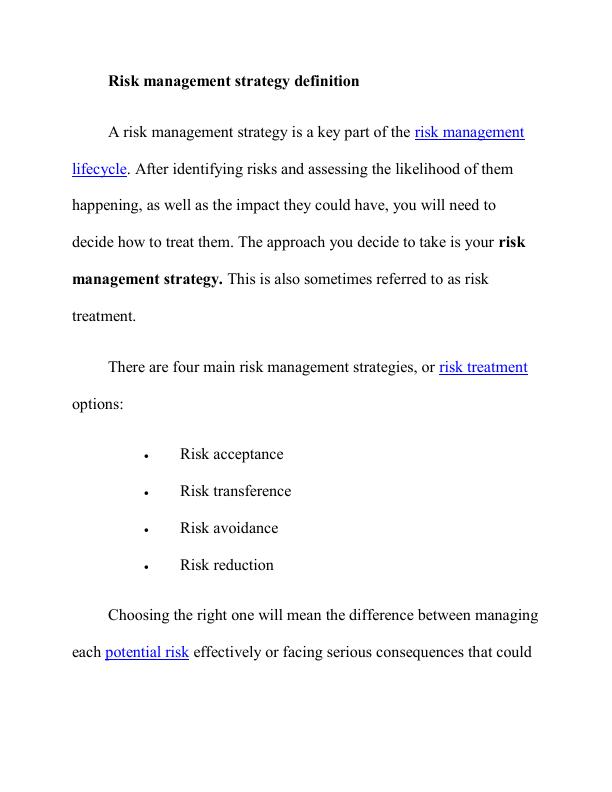
damage your business. Let’s take a closer look at what these four
approaches involve and some examples of when you could use them.
Types of risk management strategy
Risk acceptance
Risk acceptance definition: A risk is accepted with no action taken
to mitigate it.
This approach will not reduce the impact of a risk or even prevent
it from happening, but that’s not necessarily a bad thing. Sometimes the
cost of mitigating risks can exceed the cost of the risk itself, in which
case it makes more sense to simply accept the risk. After all, why spend
£200,000 to prevent a £20,000 risk?
However, this approach does come with a gamble. You will need
to be sure that, if the risk does occur in the future, then you will be able
to deal with it when the time comes. Because of this, it is best to accept
risks only when the risk has a low chance of occurring or will have
minimal impact if it does occur.
approaches involve and some examples of when you could use them.
Types of risk management strategy
Risk acceptance
Risk acceptance definition: A risk is accepted with no action taken
to mitigate it.
This approach will not reduce the impact of a risk or even prevent
it from happening, but that’s not necessarily a bad thing. Sometimes the
cost of mitigating risks can exceed the cost of the risk itself, in which
case it makes more sense to simply accept the risk. After all, why spend
£200,000 to prevent a £20,000 risk?
However, this approach does come with a gamble. You will need
to be sure that, if the risk does occur in the future, then you will be able
to deal with it when the time comes. Because of this, it is best to accept
risks only when the risk has a low chance of occurring or will have
minimal impact if it does occur.
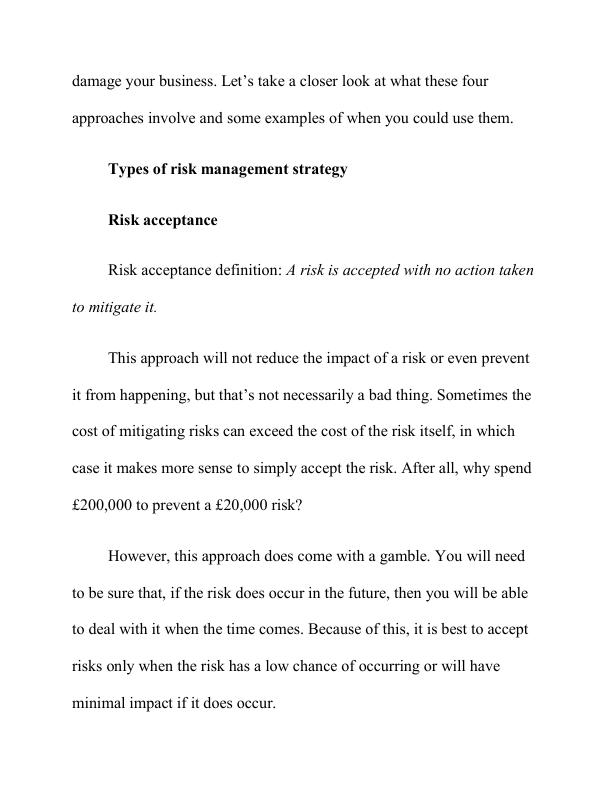
Risk transference
Risk transference definition: A risk is transferred via a contract to
an external party who will assume the risk on an organisation’s behalf.
Choosing to transfer a risk does not entirely eradicate it. The risk
still exists, only the responsibility for it shifts from your organisation to
another.
An example of this would be travel insurance. You don’t accept
the risks of a lost suitcase or an accident abroad and the costs that this
would bring – you pay a travel insurance company to bear the financial
consequences for you.
The same goes for the workplace. You may outsource work – and
the risks that come with it - to a contractor. In finance, you may adopt a
hedging strategy to protect your assets or investments.
Risk avoidance
Risk transference definition: A risk is transferred via a contract to
an external party who will assume the risk on an organisation’s behalf.
Choosing to transfer a risk does not entirely eradicate it. The risk
still exists, only the responsibility for it shifts from your organisation to
another.
An example of this would be travel insurance. You don’t accept
the risks of a lost suitcase or an accident abroad and the costs that this
would bring – you pay a travel insurance company to bear the financial
consequences for you.
The same goes for the workplace. You may outsource work – and
the risks that come with it - to a contractor. In finance, you may adopt a
hedging strategy to protect your assets or investments.
Risk avoidance
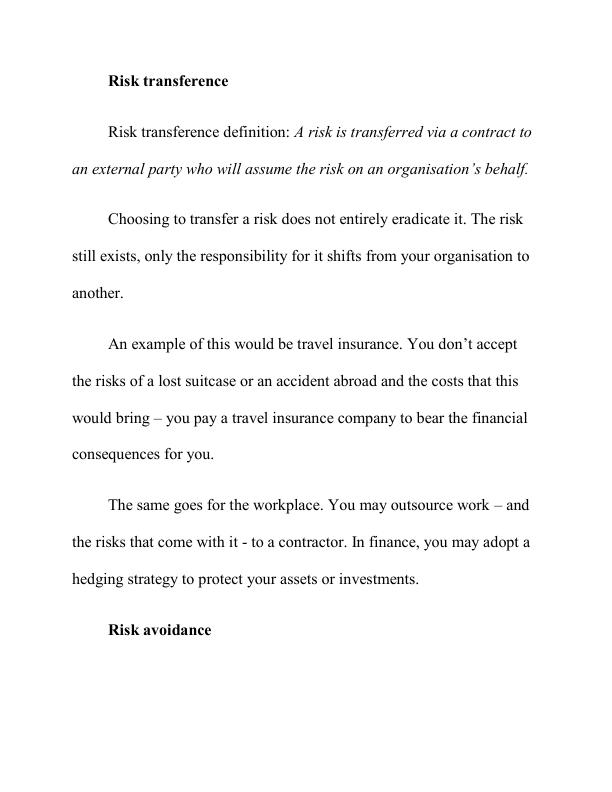
Risk avoidance definition: A risk is eliminated by not taking any
action that would mean the risk could occur.
If you choose this approach, you are aiming to completely
eliminate the possibility of the risk occurring. One example of risk
avoidance would be with investment. If, after analysing the risks
associated with that investment, you deem it too risky, then you simply
do not make the investment.
Treating risks by avoiding them should be reserved for risks that
would have a major impact on your organisation. If you avoid every risk
you come up against, then you may miss out on positive opportunities.
You never know, that investment you decided not to make could have
paid off. That is why it’s important to thoroughly analyse risks and make
the most informed judgement you can.
Risk reduction
Risk reduction definition: A risk becomes less severe through
actions taken to prevent or minimise its impact.
action that would mean the risk could occur.
If you choose this approach, you are aiming to completely
eliminate the possibility of the risk occurring. One example of risk
avoidance would be with investment. If, after analysing the risks
associated with that investment, you deem it too risky, then you simply
do not make the investment.
Treating risks by avoiding them should be reserved for risks that
would have a major impact on your organisation. If you avoid every risk
you come up against, then you may miss out on positive opportunities.
You never know, that investment you decided not to make could have
paid off. That is why it’s important to thoroughly analyse risks and make
the most informed judgement you can.
Risk reduction
Risk reduction definition: A risk becomes less severe through
actions taken to prevent or minimise its impact.
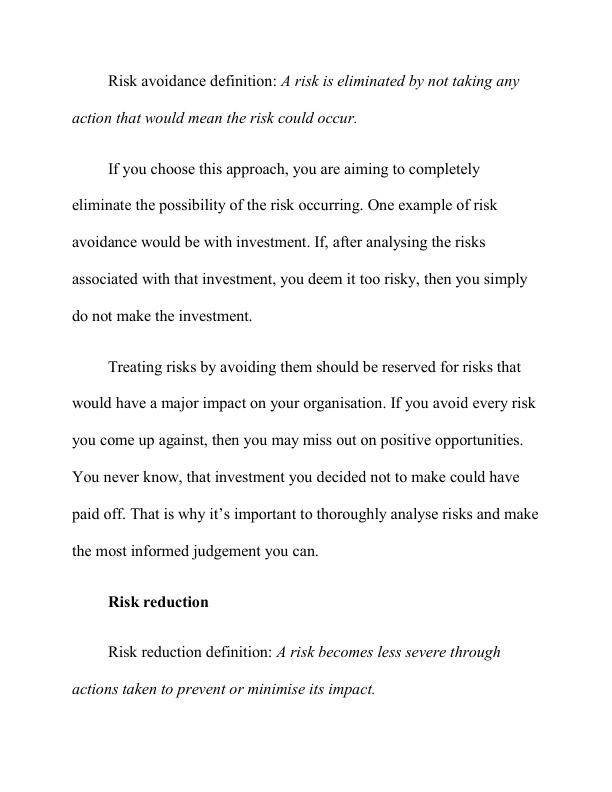
Risk reduction is a common strategy when it comes to risk
treatment, and is sometimes known as lowering risk. By choosing this
approach, you will need to work out the measures or actions you can
take that will make risks more manageable.
One example of risk reduction would be within manufacturing and
the risk of products being produced to incorrect specifications. Using a
quality management system can lower the chance of this happening, so
this would be a method of risk reduction. In the finance industry, you
may face risks associated with new regulations. Implementing a digital
solution to help you manage regulatory requirements can mitigate the
risks of non-compliance and would therefore also be an example of risk
reduction.
So which strategy should you choose?
As you can probably guess, that depends on the risk. You will need
to fully understand each risk your organisation faces so that you can
treatment, and is sometimes known as lowering risk. By choosing this
approach, you will need to work out the measures or actions you can
take that will make risks more manageable.
One example of risk reduction would be within manufacturing and
the risk of products being produced to incorrect specifications. Using a
quality management system can lower the chance of this happening, so
this would be a method of risk reduction. In the finance industry, you
may face risks associated with new regulations. Implementing a digital
solution to help you manage regulatory requirements can mitigate the
risks of non-compliance and would therefore also be an example of risk
reduction.
So which strategy should you choose?
As you can probably guess, that depends on the risk. You will need
to fully understand each risk your organisation faces so that you can
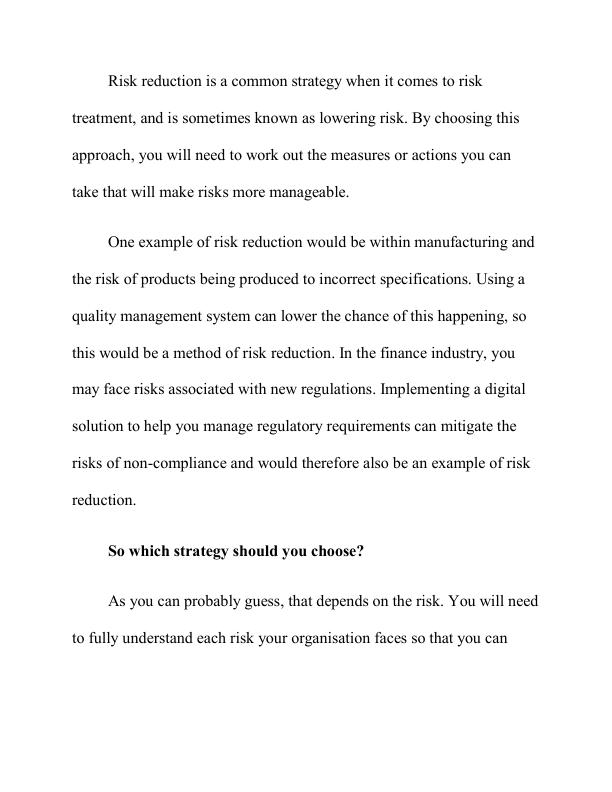
choose the appropriate strategy to treat them – whether that’s through
acceptance, transference, avoidance or reduction.
Now that you understand ‘what is a risk management strategy?’,
find out how our risk management solutions can help you make
informed decisions quickly by providing greater awareness and visibility
of risks, and more.
1. 10 Types of Risk Management Strategies to...
Having a strong approach to risk management is more important
now than ever in today’s dynamic risk environment. Following these ten
types of risk management strategies can better prepare your business for
a volatile risk landscape in 2021 and beyond.
81% of audit and risk professionals polled by AuditBoard in
October 2020 believe risk will continue to be dynamic & unpredictable
in 2021.
acceptance, transference, avoidance or reduction.
Now that you understand ‘what is a risk management strategy?’,
find out how our risk management solutions can help you make
informed decisions quickly by providing greater awareness and visibility
of risks, and more.
1. 10 Types of Risk Management Strategies to...
Having a strong approach to risk management is more important
now than ever in today’s dynamic risk environment. Following these ten
types of risk management strategies can better prepare your business for
a volatile risk landscape in 2021 and beyond.
81% of audit and risk professionals polled by AuditBoard in
October 2020 believe risk will continue to be dynamic & unpredictable
in 2021.
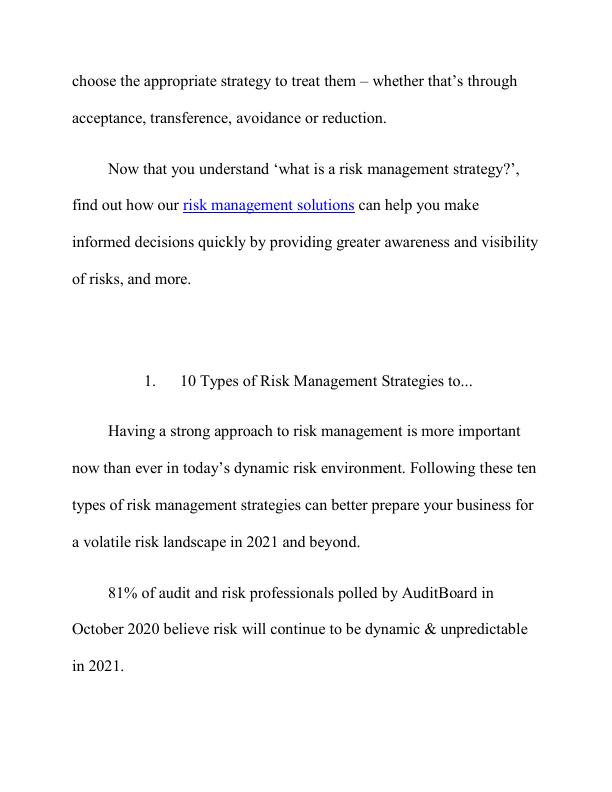
McKinsey found that when banks shut branches and corporate
offices, it altered how customers interact with them, forcing changes to
long-held risk-management practices in order to monitor existing risks
and guard against new ones.
Regardless of industry, how quickly and effectively risks can be
identified and managed will determine how well companies and
institutions will recover and rebuild — and this requires rethinking risk
management strategies. As organizations increase their focus on
identifying, mitigating, and monitoring risks in response to an ever more
volatile risk environment, you may have questions about who is
responsible for developing a risk management strategy and what are the
different risk management strategies? Here’s everything that you need to
know to better address today’s top risk areas.
What Is a Risk Management Strategy?
A risk management strategy is a structured approach to addressing
risks, and can be used in companies of all sizes and across any industry.
offices, it altered how customers interact with them, forcing changes to
long-held risk-management practices in order to monitor existing risks
and guard against new ones.
Regardless of industry, how quickly and effectively risks can be
identified and managed will determine how well companies and
institutions will recover and rebuild — and this requires rethinking risk
management strategies. As organizations increase their focus on
identifying, mitigating, and monitoring risks in response to an ever more
volatile risk environment, you may have questions about who is
responsible for developing a risk management strategy and what are the
different risk management strategies? Here’s everything that you need to
know to better address today’s top risk areas.
What Is a Risk Management Strategy?
A risk management strategy is a structured approach to addressing
risks, and can be used in companies of all sizes and across any industry.
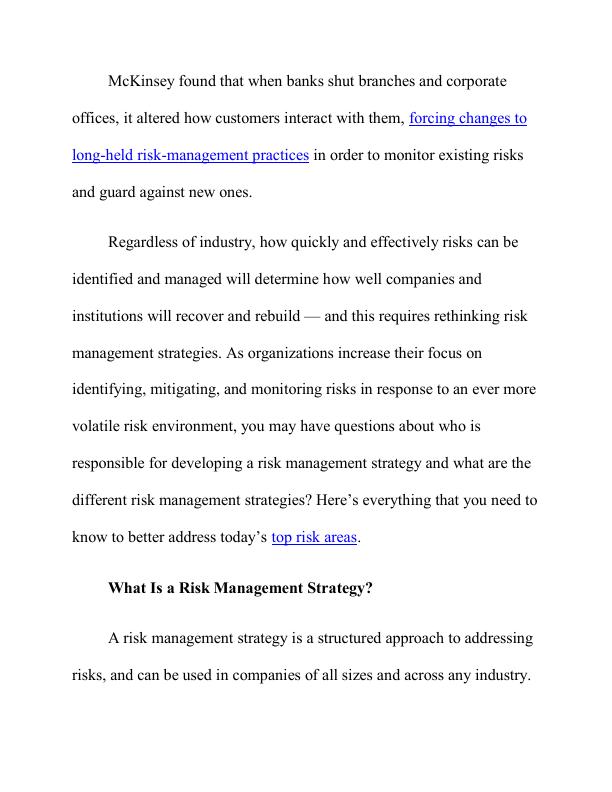
Risk management is best understood not as a series of steps, but as a
cyclical process in which new and ongoing risks are continually
identified, assessed, managed, and monitored. This provides a way to
update and review assessments as new developments occur and then to
take steps to protect the organization, people, and assets.
Identifying Risks
Risk identification can result from passively stumbling across
vulnerabilities or through implemented tools and control processes that
raise red flags when there are potential identified risks. Being more
proactive rather than reactive is always the best approach to reducing
risk points.
Assessing Risks
Once potential risks have been identified, each risk should be
assessed to determine the likelihood of it becoming a concern, its level
of severity, and the probable impact — this helps audit teams prioritize
each risk. Whether your audit team is conducting a risk assessment for
cyclical process in which new and ongoing risks are continually
identified, assessed, managed, and monitored. This provides a way to
update and review assessments as new developments occur and then to
take steps to protect the organization, people, and assets.
Identifying Risks
Risk identification can result from passively stumbling across
vulnerabilities or through implemented tools and control processes that
raise red flags when there are potential identified risks. Being more
proactive rather than reactive is always the best approach to reducing
risk points.
Assessing Risks
Once potential risks have been identified, each risk should be
assessed to determine the likelihood of it becoming a concern, its level
of severity, and the probable impact — this helps audit teams prioritize
each risk. Whether your audit team is conducting a risk assessment for

End of preview
Want to access all the pages? Upload your documents or become a member.
Related Documents
Risk Management Plan - Assignmentlg...
|16
|5894
|36
Project Management: Risk Treatment Methods and Strategieslg...
|5
|647
|366
Safety and Risk Management : Positive and Negativelg...
|5
|748
|20
Risk Treatment Methodslg...
|4
|811
|24
Assignment | Artificial Intelligence Opportunities for Enhancing Humanlg...
|21
|4745
|22
Risk Management Strategies for Project Managementlg...
|3
|611
|171